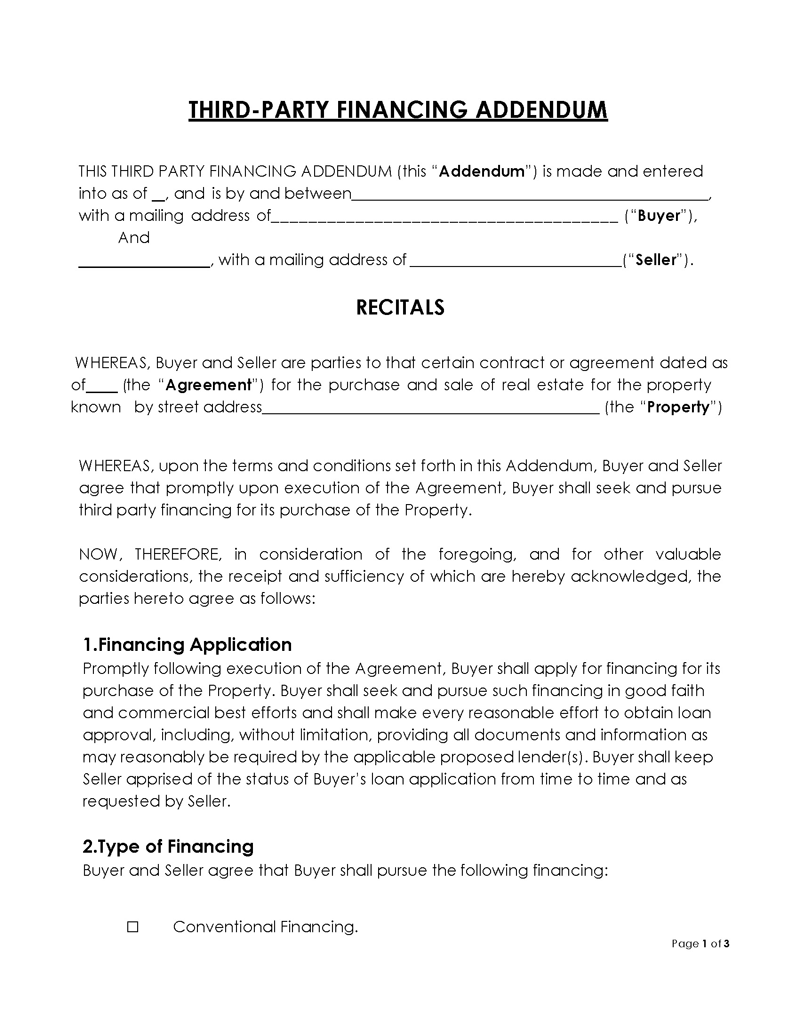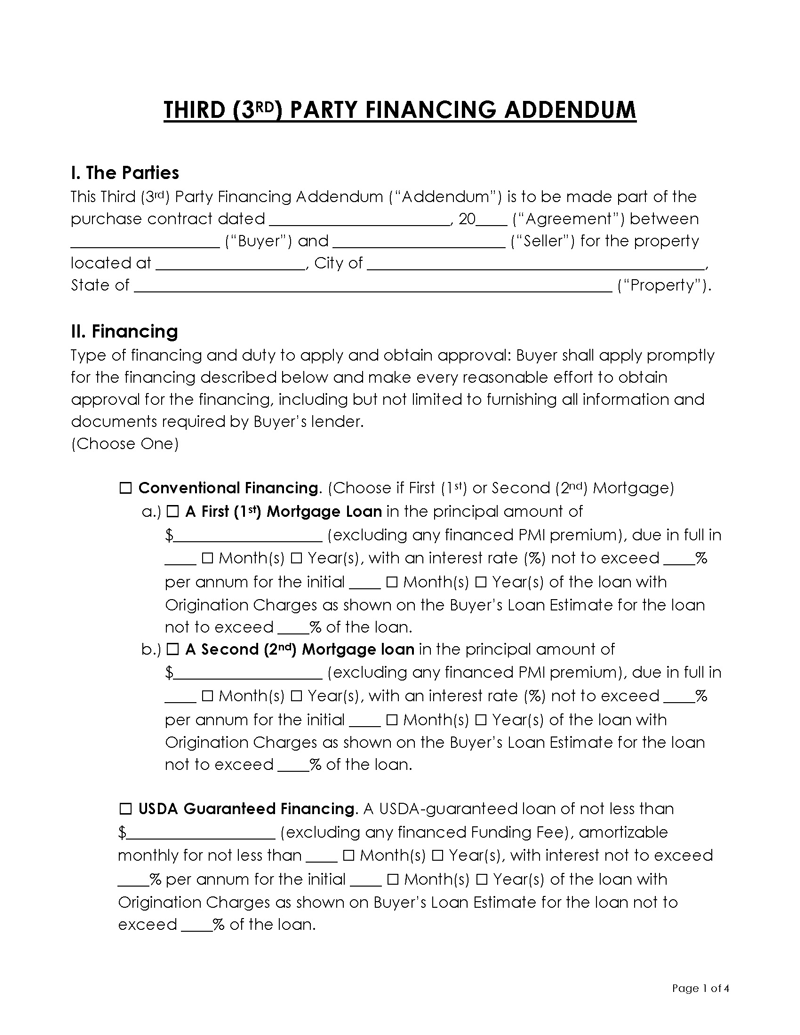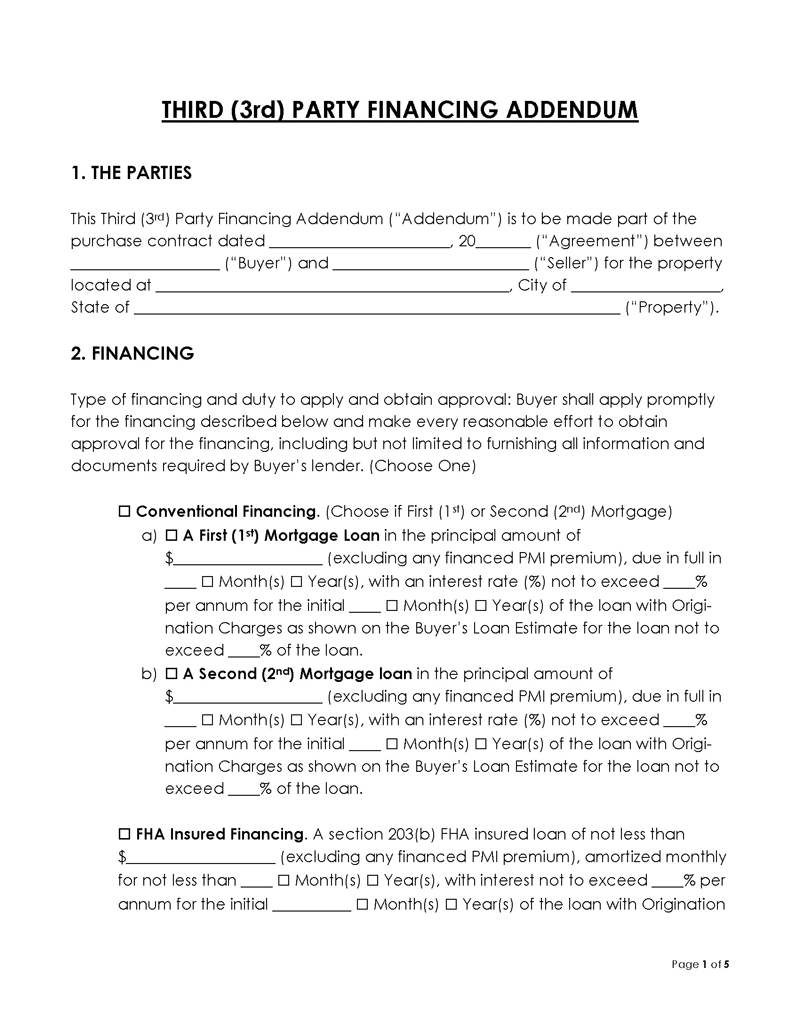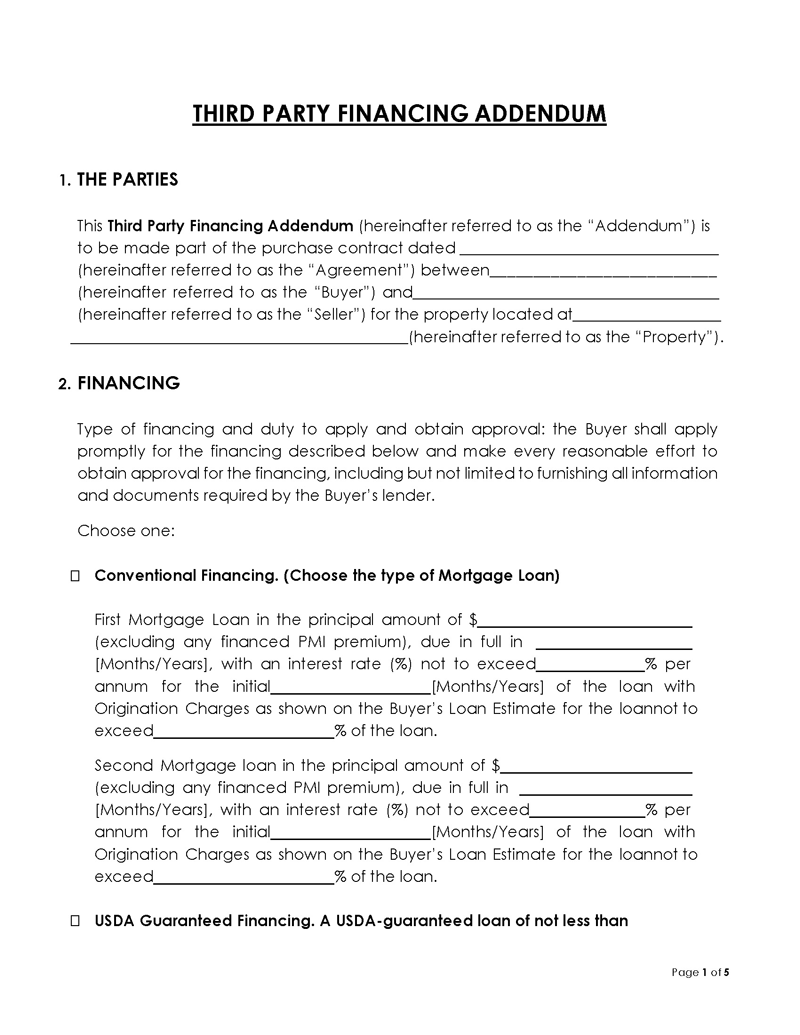Third-party financing is a common alternative in real estate. If a buyer decides to finance their real estate purchase through this method, they will often require the seller to sign a third-party financing addendum. The addendum will outline the different financing terms and what each party can expect from the arrangement. The addendum is then attached to the purchase contract and presented to the lender for credit approval.
Credit approval typically requires the terms of the loan to be outlined in the addendum and the buyer to be approved by the lender after assessing their income, credit, and assets. The seller sells the property to the buyer while offering them an option to obtain the funds from a third party. However, the option is valid for a limited period/time frame (deadline), defined in the addendum. Should the buyer fail to get approval for the loan (or within the time frame), they must notify the seller through notice. Failure to do so and the deadline expires, the buyer remains obligated to the purchase contract and is legally expected to buy the property in question or face penalties.
However, suppose the loan is not approved, and the seller is notified. In that case, the buyer is awarded the opportunity to walk away from the purchase contract and recoup their earnest money without penalties. Conversely, if the loan is not approved within the time frame, the buyer may still be contractually obligated to the seller, and the seller can enforce the purchase contract through litigation. This is especially dangerous if they don’t notify the seller of the loan denial.
As such, buyers will want the time frame to be as long as possible in order to secure enough time to acquire financing and walk away from the contract without legal battles. On the other hand, sellers will want the shortest time frame to avoid a situation where the loan is not approved after waiting for too long. Therefore, both parties should find a mutually acceptable time frame.
This article will adequately cover the different types of third-party financing addendums and guide you on how to create one.
Third Party Financing Addendum
The addendum is a contract between the buyer and seller. The primary purpose of this addendum or contract is to detail the terms of a third-party financing arrangement between buyer and seller, which will help them secure approval from lenders before a specified date.
The term “third-party” refers to the person or entity granting assistance for funding for real estate purchases, such as a bank. The document is attached to the purchase/sales contract. In this case, the purchase is contingent on the loan getting approved by the third party. If the loan is approved, the sale should be completed typically within 30 days. Conversely, if the loan is not approved and the buyer notifies the seller, the sales contract is voided, and the earnest money is refunded.
Free forms
Creating the addendum is straightforward, especially when using a template. You can download professionally designed templates from here for free. They outline the critical sections of a standard third-party financing addendum. Therefore, all you need is to adjust it to your needs based on the type of loan you will be using.




Types of Financing Addendum
Buyers and sellers have different options of loan types they can explore with the addendum. Each type of loan determines the type of addendum.
The common types of addendums used for third-party financing are:
Conventional financing
This type covers the conventional loan and can cover the first and second mortgage. The addendum outlines the loan terms.
Such terms include:
- Loan amount
- Loan period (15 years, 20 years, 30 years, etc.)
- The maximum interest rate and how long it will be applicable. The interest duration can vary if the loan is an adjustable-rate mortgage.
- The origination charge is the fee charged by the lender for processing the loan application. If the addendum states that the fee is 1% of the borrowed amount, the lender shouldn’t charge more than this. If they do, the buyer gets the benefit of walking away from the contract as the stipulations of the addendum were unacceptable to the lender.
Texas veterans loan
This is an addendum for veterans in Texas who want to purchase property through third-party financing. The addendum indicates the loan amount and the years the money will be loaned. The Texas Veterans Board determines the interest rate of Texas veterans loans.
FHA insured financing
The addendum can also be used to secure Federal Housing Administration (FHA) loans to purchase the property. There are different FHA loans, the most common being the 203(b) and the 203(k) – alternatively referred to as a renovation loan. The FHA section is structured following KHA requirements.
Some of the requirements include:
- The addendum contains extra rhetoric that makes it enforceable for FHA loans.
- The property/home must be appraised, and the value should be recorded in the contract. The appraised value must match the purchase price quoted by the seller. If not, the buyer can terminate the agreement with no repercussions, no penalty and receives their earnest money in its entirety.
- The buyer can proceed with the purchase even if it exceeds the appraised value as long as they cover the difference between the two valuations.
It is advisable to indicate the appraised value in the contract because if this is not done, the FHA loan will often fall apart since most buyers don’t have a readily available amount to cover the difference. Yet, most sellers refuse to sell their property for a lower amount.
Reverse mortgage financing addendum
This is an addendum used in cases where a buyer only qualifies for a home equity loan. This is financing that is based on the buyer’s equity in their current home/residence. This addendum is available to individuals aged 62 years. The addendum specifies the loan and supporting details provided in the purchase contract.
VA guaranteed financing
Eligible veterans use this type of third party financing addendum to secure loans from private lenders such as banks, mortgage companies, etc. The addendum offers buyers the same buyer protection as FHA loan requirements. The property has to be appraised, and the appraisal value to be compared with the purchase price. If there are discrepancies, the purchase contract is voided, and the buyer will receive their earnest money without penalties.
USDA guaranteed financing
If the buyer wants to apply for a USDA (US Department of Agriculture) loan, the loan terms negotiated with the seller should be recorded in the addendum. Low-income individuals typically request this loan in rural areas.
How to Write Third (3rd) Party Financing Addendum
Before writing the addendum, both parties (buyer and seller) have to give consent. If either of them has any objections, they are not supposed to go ahead with the deal.
Below is a general guide on how to write an addendum:
Addendum date
The date of the addendum should be indicated. The date should show the day, month, and year. The date gives the document a time stamp that can be referenced for filing or legal purposes.
Name of the concerned parties
The parties of the contract should then be identified. Provide personal identification details. This should include the full names of the buyer and seller as well as their addresses. Also, indicate any registered business name (if any) to make it easier for lenders to search.
Location of the property, city, and state
Next, the property should be identified by listing the street address, city, and state in which it is located. Lenders will want to verify the location of the property. The situation can also provide details such as building and suite numbers.
Type of financing
Then, specify the type of financing. Different addendums include conventional mortgage, FHA insured financing, USDA guaranteed financing, and VA guaranteed financing. The standard addendum will outline the different financing options available. The type of third-party financing should thus be indicated by selecting the appropriate box. Since loan terms vary from arrangement to arrangement, it is important to specify all loan terms such as amount, origination charge, interest rate, loan duration, etc.
Lender’s power and approval deadline
The addendum should also have a statement indicating that the buyer has been awarded a deadline for getting the lender’s approval for the loan, after which the third-party financing option becomes void. The deadline should be specified by indicating the day, month, and year. This gives the parties a timeline to adhere to. The statement should clarify the consequences of failure to adhere to the time restrictions.
If the buyer has already secured the approval for financing, the addendum should state so. Also, the addendum should state the lender’s powers, such as the power to perform an appraisal, deed search, material defects, insurability, or any other due diligence to approve the property for purchase through the borrowed funds. The applicable deadline for property approval should also be indicated.
Seller and buyer’s signature with date
The addendum should have a section stating the buyer’s and seller’s signatures and the respective signing dates. This is to confirm acceptance of the terms and conditions of the addendum. The signatures also consent to release information of approval to the buyer, seller, or their representatives. Once signed, the document becomes binding, and both parties are expected to abide by its stipulations.
Related: Addendum to Lease Agreement (Free Forms & Templates)
Key Takeaways
- Third-party financing is a practice in real estate that allows buyers to purchase property through loans from third parties such as banks, creditors, mortgage loan agencies, etc.
- The addendum outlines the general terms and conditions of the arrangement between the buyer and the seller concerning securing the home loan.
- The addendum is legally enforceable once signed, and if violated, legal consequences can be pursued by either party.
- The addendum can be used for different types of financing; conventional loans, FHA-insured financing, Texas veterans loan, VA guaranteed loans, reverse mortgage financing, and USDA guaranteed loans.
- The document has to be signed and attached to the sales/purchase contract.




